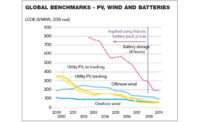Solar and wind energy increasingly are competitive with conventional energy on cost, but their weather-dependent nature undermines confidence in them. A new entrant in the energy-storage market set to launch in November will address that concern.
Lugano, Switzerland-based Energy Vault LLC will offer a modular, gravity-operated system capable of delivering 10 to 38 MWh of energy storage per module. The ability to add modules removes the limits on storage capacity.
The Energy Vault’s lattice-steel towers, 90 to 140 meters tall, are topped by two to six crane arms and surrounded by stacks of concrete weights called bricks. The cranes charge the system with potential energy by lifting the bricks into stacks, then discharge the energy by lowering them, driving a generator. It operates on the same principle as a pumped hydroelectric storage system, in which water is pumped uphill to a high reservoir when generation exceeds demand, then is discharged to the low reservoir through a hydro turbine when demand is higher.
The weights are shaped like big masonry bricks, 4 m high, 2.2 m wide and weighing 35 tonnes each. They are fabricated on site from a mixture of materials that may include debris concrete, cement or soil-composite material.
Charging power can come from either renewable energy or direct connection to the grid, says Robert Piconi, Energy Vault CEO. Software algorithms automate the movement of the crane and trolleys and the charging, discharging and other operations. “Our system can respond in milliseconds to fluctuations in power demand,” Piconi says.
“Wind loading has a very small effect on our system [because] the ratio of cross-sectional area to mass is extremely low,” Piconi adds. Seismic simulations by Cal State influenced the final design. “In addition to shutdown risk, software accounts for various motion-related factors, including wind and inertia,” he says. “Our initial market entry pricing will be $200-250/kwh depending on location, with future volume pricing substantially lower.”
“At the end of 2017, we had less than 1.3 GWh of energy storage installed in the United States,” says Nick Esch, senior research associate for the Smart Electric Power Alliance. “I foresee this being a massive market opportunity.”



Post a comment to this article
Report Abusive Comment